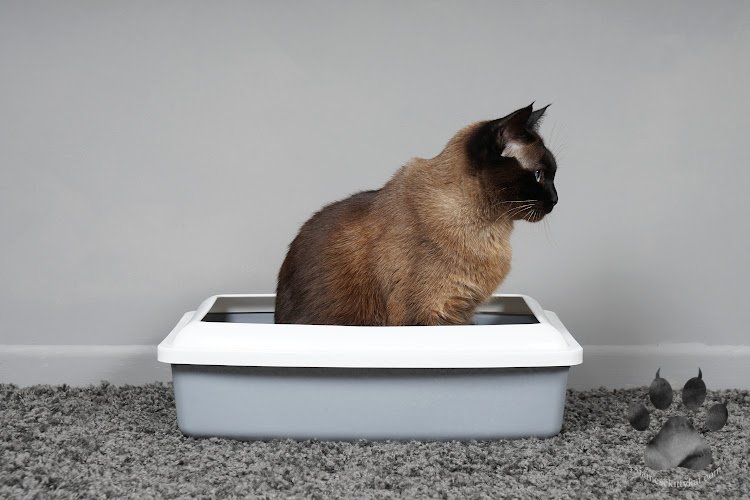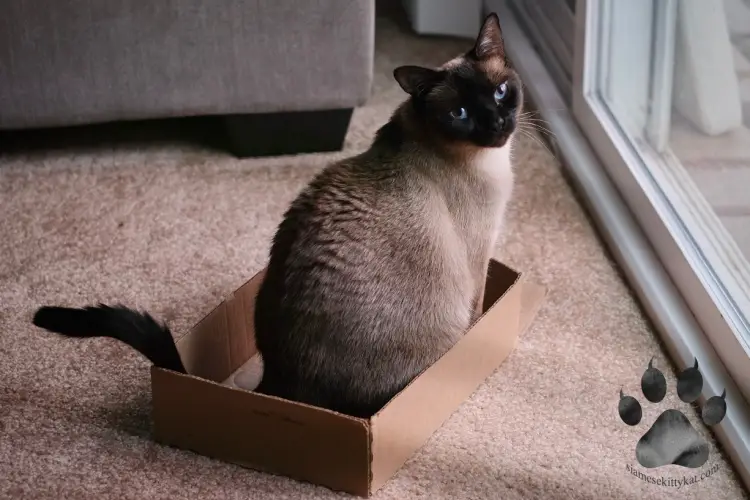What’s better than a Siamese cat? A Siamese cat that knows how to use a litter box! While that may have seemed like a setup, your feline suddenly refusing to use the litter box is anything but a joke.
It’s completely normal for a kitten or newly trained house cat to have a few toilet issues here and there. But, when your Siamese suddenly decides the litter box isn’t for them, there’s a huge problem – and I’m not just talking about the clean-up!
There are a few reasons why your Siamese may not like their litter box anymore: they’re anxious, their surroundings have changed, they’re struggling with a UTI or other health problems.
In this article, I will cover the main reasons why your Siamese isn’t doing their business in the office anymore, as well as some ways to get them back on track.
Why has my cat started peeing on the floor?
If your Siamese has gone from using the litter box carefree to avoiding it like the plague, this could be a sign that something serious is at play.
Much like human babies, kittens have no idea what a potty is. So, they will go to the toilet wherever they please. It’s up to their mothers to teach them where to go to the bathroom.
Kittens will typically learn to use the litter box at 4 weeks of age. If your Siamese has a housecat mother, they will usually begin to use the litter box almost straight away.
If your Siamese was born to a stray or is a stray themselves, chances are they will have no experience with a litter box. In that instance, it is perfectly normal for them to not understand how to use one.
Urinating outside of the litter box, also known as ‘inappropriate elimination,’ can happen for a number of reasons.
It could be due to the litter box placement, environmental changes, stress, or underlying health issues.
Whichever it may be, inappropriate elimination is a cry for help.
Why is my cat peeing all over the house all of a sudden?
If your Siamese has started peeing all over the house, this could mean they have a few territorial issues. This usually happens with cats that have yet to be neutered or spayed.
Spaying will look different from normal urinating, so it will be easy to tell the two apart.
When your Siamese sprays, they will back up onto a virtual surface and raise their tail when spraying urine. When they urinate, as usual, they will squat.
Inappropriate elimination will happen just about anywhere – on the carpet, in the corner of the room, on the bed. Your Siamese is simply trying to relieve themselves anywhere but the litter box.
Spraying on the other hand usually happens on belongings and new things brought into the house. This is an attempt at marking their territory.
While males are the main culprit of spraying, females can spray too. Spraying is commonly related to sexual and dominant instincts, it can also be the result of anxiety and territorial issues.
The best solution is to get your Siamese spayed ASAP. This will not only stop them from urinating all over the house, but it will also protect them from certain diseases.
If your Siamese has already been spayed, chances are their spraying is due to stress-related things. You will have to identify their source of anxiety to see if that helps the issue.
Why is my cat not using the litter box?

There are a few reasons why your Siamese may have stopped using the litter box. Some of these problems are easy fixes, whereas others are related to medical issues.
The best way to eliminate any medical issues is to take your Siamese for a check-up at the vet’s. They will be able to examine your Siamese to rule out any problems that may be stopping them from using the litter box.
First, let’s go over 3 common medical issues that may be causing your Siamese problems:
1. Feline Lower Urinary Tract Disease (FLUTD)
Used to refer to a range of problems related to the bladder. This includes urine infections, bladder stones, and inflamed bladder. This can cause a whole lot of discomfort, making your Siamese go to the bathroom even if they don’t need to. Signs include voiding, straining, and blood in the urine. Both males and females can have FLUTD, however, it is more life-threatening to males.
2. Unusual Amount Of Thirst
If your Siamese consumes more water, it is only natural they will have to use the bathroom more often. There are a few medical issues that can cause your Siamese to do so, and this urge to urinate overrides the need to use a litter box.
3. Arthritis And Old Age
Due to old age or arthritis, your Siamese may be experiencing too much discomfort using the litter box. Climbing in and out of a deep tray will have them giving up before you know it. They may even link their pain to the litter box, avoiding it completely.
If you’ve ruled out medical problems, it’s time to go on cat watch. It can be quite difficult to figure out why your Siamese isn’t using the litter box, so you will have to watch them carefully.
It will take a lot of persistence, understanding, and patience. However, it will be worth it in the end!
Non-medical related problems include:
4. Dirty Litter Box
I’m sure you’d hate to use a dirty, smelly bathroom. Well, your Siamese is the same. They have a nose 40 times more sensitive than yours! In the wild, predators will use waste to locate their prey. Even though Siamese cats are domesticated, they still have this instinct.
Solution – Clean out that litter box – it’s as simple as that. You should scoop their litter twice a day (depending on the litter type used.) Once a week, you should empty their box completely and give it a wash with soapy water.
5. Litter Type
Cats are picky, from the food they eat to the litter they use. Some litters may be highly perfumed, which irritates the sensitive noses of Siamese cats. Some may not be bothered by this, others will refuse to use the box because of it.
Solution – Experiment with litters to see which one they like. You can purchase a small bag of each litter so you don’t waste anything.
Still unsure which litter type is best fits your cat? I luckily just made an article about that! Simply click the link so I can help you choose the best litter for your Siamese cat.
6. The Litter Box
When it comes to the litter box itself, you have to ensure you have the right one for your kitty. There are hundreds to choose from: Ones with hoods, tall sides, short sides, deep pans, and shallow. If you have one that doesn’t fit with them, they simply will not use it.
Solution – Try a range of boxes in different shapes and sizes. If you think the litter liner is bothering them, remove it.
If you don’t have the time to try out different litter boxes, no need to worry, I reviewed the best cat litter boxes just for you! Just read the article and check out which litter box came out best.
7. Placement
If your kitty doesn’t like the location of their box, they won’t use it. If it is near their food, they will avoid the bathroom due to cleanliness. If they are easily stressed, they will be too scared if their box is near a noisy washer or heater.
Solution – Move their box to an easily accessible area, away from food, water, and anything noisy. They want to feel safe when using the bathroom, so ensure it is a quiet and stress-free environment.
8. Multi-cat Household
Cats are incredibly territorial, therefore using the same litter box as their siblings is a big no-no. They also have a pretty complicated hierarchical system, so some cats may feel like they can’t go to the bathroom near their ‘boss’.
Solution – All multi-cat households should have one litter box per cat, plus a spare. This allows all cats to have their own space.
9. Environmental Problems
Siamese cats are creatures of habit. They stick to their schedules and absolutely hate change. So, if you’ve noticed your Siamese avoiding the litter box after a change in the household, they may be anxious about something.
Solution – Making your Siamese feel included is a great way to ease anxiety. This could be giving them some extra love or some extra treats – anything you can do to show them you’re not going anywhere.
Temptations Cat Treats is what always worked for my 2 lovely Siamese buddies. If you think it’s something your Siamese cat would like (I’m pretty sure they will), you can get them from Amazon through the link above.
Why is my cat peeing again and again?
If you find your Siamese peeing often, you first have to identify the cause. You should also note if they’re attempting to urinate often and failing, or if they are urinating in volume.
There are a few reasons why your Siamese is peeing often:
UTI (Urinary Tract Infections)
UTI is the most common cause of frequent urination. This is due to a buildup of bacteria inside the urinary tract. A UTI will urge them to pee frequently, but they will only be able to pee a little at a time, sometimes not at all.
UTI’s are very easy to treat when caught early and can affect all ages and breeds. Middle-ages cats who are overweight, however, have a higher chance of contracting a UTI.
Bladder Stones
Bladder stones block the neck of the bladder with a rock-like crystal. Siamese cats who suffer from this blockage are unable to go to the bathroom, however, they will try over and over again.
An untreated blockage may lead to kidney failure, so it’s incredibly important to get it treated ASAP.
Bladder stones can affect any breed and age, however middle-aged male Burmese, Persians, and Himalayans are most susceptible.
Diabetes
In an attempt to flush out the excess sugar, your Siamese may intake a lot more water. Since they drink more often, they will want to use the bathroom more often. They also may seem a lot hungrier than normal.
Type 2 diabetes can be developed by cats of any age but is more common in overweight males.
Hormonal Imbalance
An overactive thyroid will also cause frequent urination, also known as hyperthyroidism. This disease can be caused by a benign tumor in the neck and can affect the other organs in your Siamese cat.
Hyperthyroidism most commonly affects middle-aged to mature cats.
How can you tell if your cat has a UTI?
If your Siamese has trouble using the bathroom, it may be a sign that they have a urinary tract problem (UTI).
If your Siamese suffers from a UTI, they won’t be able to urinate properly. If so, you may find the following symptoms:
If you notice any of these symptoms, you should contact your vet ASAP. If left untreated, a UTI can develop into a kidney infection.
How do I stop my cat from peeing everywhere?

A lot of the time, the reason a cat will refuse to use a litter box is down to the box itself. If you’ve ruled out medical issues, it’s time to look at other aspects of your feline’s life.
The best way to keep your cat using their litter box is to ensure they live a happy, stress-free life. A healthy cat with no environmental issues will greatly decrease the chances of inappropriate elimination.
How do you litter train a Siamese cat?
The best time to litter train your Siamese is to do it from kittenhood. Mothers tend to do this themselves, however, you may need to step in during certain circumstances.
Here are the steps you need to take to litter train your Siamese:
Step 1 – Choose The Right Box
Cats love to dig and play in their trays, so you need to ensure they have the proper space to do so. Picking the right tray for your Siamese is the first step on the training adventure.
Kittens are small, so I recommend starting off with a small tray. As they grow, you should work your way up in size.
If you’re having trouble choosing a box, start off with something simple that is easy to get in and out.
Step 2 – Choose The Right Litter
There are a ton of litters on the market, so finding the right one for your Siamese may be harder than it seems. A few of these litters include:
If you can, you should always test out a few litters. You may be able to get your hands on some sample packs to save waste and money.
If you have adopted your Siamese or your kitten has come from a breeder, it would be a good idea to use the same litter they are used to. You can also mix the old litter within the new so they can get used to it gradually.
Step 3 – Use A Confined Room
You should always start in a confined room when litter box training. Show them where the box is by carefully placing them inside. This will encourage them to explore the box and hopefully, begin using it.
The litter box should always be in view so your Siamese knows where it is. Once they have gotten used to using the box, you can move it to another place in the house.
Step 4 – Put In A Quiet Place
Placement is a huge part of the process. If the box is placed in a loud and uncomfortable area, they will simply avoid using it. Siamese cats need a little privacy, despite giving you none. So, the box should be out of the way, in a quiet place.
You also shouldn’t place the box next to any food or water, in the laundry room, or near any drafty places.
I place my litter boxes in the bathroom, though not all cats will like that. There should, however, be a box on every floor of the house.
Step 5 – Keep The Box Clean
Think of it this way, would you want to use a dirty toilet? Siamese cats are the same! They will not use a dirty box as they are clean creatures by nature.
Depending on the litter used, you should scoop the box at least once a day, and clean the entire box once a month. The box should also be replaced each year.
If these tips still don’t work, check out this in-depth guide on what to do when your Siamese cat won’t use the litter box.
Is it normal for a Siamese not to use a litter box?
No, it is not normal for your Siamese to suddenly stop using the litter box. There are many reasons why your Siamese won’t use their box, both medical issues as well as environmental ones.
If your Siamese is having trouble going to the bathroom, you should get them checked out by the vets as soon as possible.
Kitties hate a dirty litter box, therefore you should always keep it clean and inviting. They’re also finicky creatures, so it may take some experimenting with the right litter and box.
First and foremost, don’t get any or upset with your Siamese. They aren’t doing it on purpose – think of it more as a cry for help. It’s just a part of your parenthood!
Want to learn more about your Siamese cat’s behavior? We have compiled every information you need to navigate through the fascinating world of Siamese cats: Everything About a Siamese Cat’s Behavior: A Comprehensive Guide
Get your FREE Siamese Cat 2026 Printable Calendar

